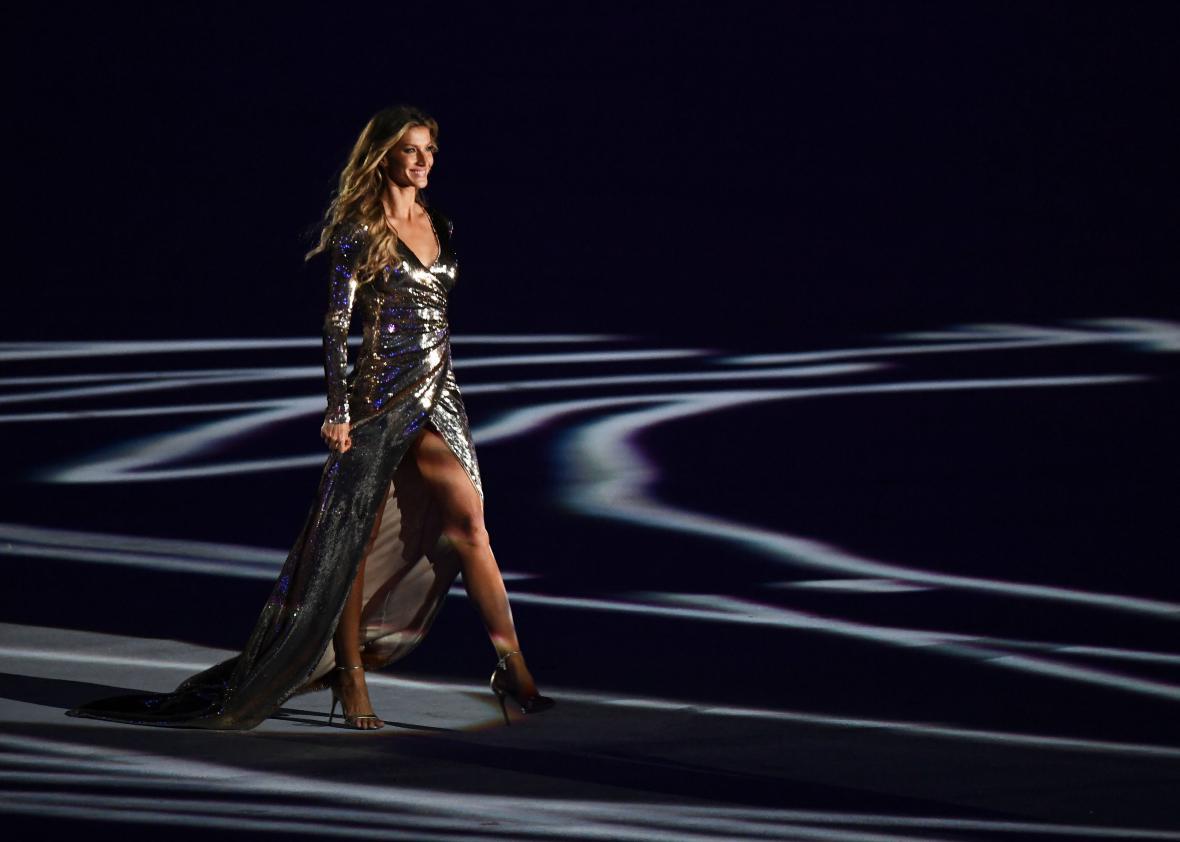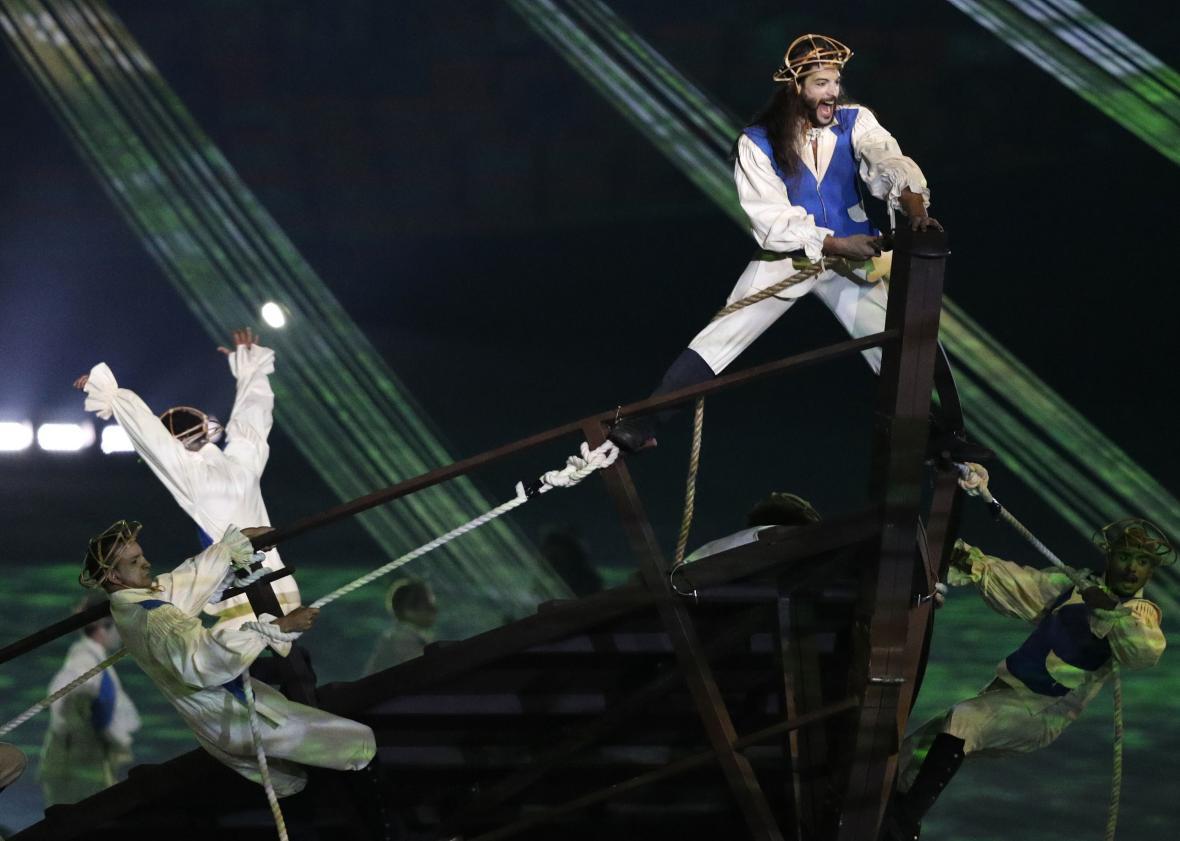The runup to the Olympic is often rife with schadenfreude: Would Bejing’s Bird’s Nest get finished in time? Would London become one giant traffic jam? Who would save the stray dogs of Sochi? But the concerns about Rio have been more serious than even the robberies, the sewage in the bay, and the body parts washing up on the beach volleyball site might suggest. The 2016 Summer Games, the first to be held in South America, are taking place amid Brazil’s worst recession in 100 years, a political crisis, and a health emergency. Anger about the games’ expense and the graft, corruption, and evictions surrounding it have led to protests, even as the Olympic flame has made its way through Rio this week—not exactly a fitting backdrop for something like the cheeky extravaganza on display at the opening ceremony in London, let alone the kind of nationalistic triumphalism of Beijing and Sochi.
The Rio opening ceremony, overseen by director Fernando Meirelles (City of God), was described by its creators as “analog” and MacGyver-esque. It reportedly had around half the budget of London’s opening ceremony, which cost 42 million pounds (smoke stacks don’t come cheap). But even more than cost constraints, the national context in Brazil precludes a certain kind of blithe spectacle. If it is possible to call anything austere that involves dancers dressed head to toe in tinsel, like yetis who have been mistaken for Christmas trees, then this was a kind of austerity opening ceremony, straining to say something substantive with relatively limited means, trying to prove with its message that the Olympics are more than just a boondoggle.
The opening ceremony was relatively matter of fact about two things opening ceremonies are not usually forthright about: the host nation’s and the world’s problems. The evening began in Maracanã Stadium with hundreds of dancers waving massive sheets of Mylar in shimmering harmony, as if ready to warm hundreds of giant marathon runners post-race. It soon turned to the creation of the Amazon, and an arboreal peace sign. A handful of kinetic sculptures, representing microbes, walked the stadium floor, leaving green in their wake. Long pieces of string and light beautifully represented the forest, which was slowly populated. First came indigenous people; then the Portuguese, in clever partial boats; then enslaved Africans, wearing wood blocks on their feet to stand in for shackles; then immigrants from Syria, Lebanon, and Japan, each group leaving behind a trail of development, a streak of white on the rainforest’s green floor. Later in the night, the aforementioned tinsel yeti, some in red, some silver, some gold, danced at each other in rectangles of light, meant to illustrate the differences that continue to divide Brazilian society.
Cirque du Soleil–style performance art may not be the most effective way to explore a nation’s foul and traumatic history, but compare this acknowledgment of slavery to the Sochi ceremony, which neatly elided unpleasant aspects of Russian history (Stalin, gulags, Communism). Then imagine an opening ceremony in the United States, where the legacy of slavery and the question of immigration are so deeply controversial; a show that highlighted either would be interpreted as a partisan salvo in the culture wars. Friday’s ceremony was an acknowledgment that all these different groups, some brought against their will, have been integral to the creation of a nation, a nation that is still a work in progress.
The ceremony then turned into a party, the singing and dancing portion of the night. Purely as a spectacle, this pageant had nothing on Beijing or London, not that it didn’t have its memorable images, particularly the birth of the city, which bloomed in the corner of the arena and was soon beset by young people dressed in hot pink, doing parkour all over its shrunken balconies. This set looked great on television, but it took up just a tiny corner of the stadium, a cost-saving measure. A trick with a series of boxes, meant to obscure a surprise, could only have worked for the TV audience at home. That surprise—an airplane—took off into the sky, but then a video took over. The pop-up buildings, an insta-favela, went on to serve as a stage for a medley of different styles of music and dance, leaving the vast floor of the stadium largely unused, except by a handsome geometric light show. (The shape outlined on the floor was apparently inspired by the shape of Copacabana Beach—not that you would know that from NBC’s laughably clueless announcers, who seemed almost tongue-tied by most of the ceremony.) Whereas at London and Sochi and Beijing it felt as every inch of the arena floor was covered with hundreds of people most of the time, Maracanã had much empty space.

Franck Fife/AFP/Getty Images
The smaller scale of this opening ceremony was further illustrated when Gisele appeared, apparently taking her last professional cat walk across the stadium floor, as “The Girl From Ipanema” played. Gisele was reportedly supposed to participate in a segment that got cut for being insensitive, so instead she simply walked, accompanied by squiggly lights meant to represent the work of a Brazilian architect. It was a remarkably slow-moving moment in a ceremony that made no effort to match the frenetic pace of previous Olympics galas. Gisele looked much more amped later, when NBC couldn’t stop cutting to her dancing fiercely with other performers, but still. At the London opening ceremony, the queen looked as though she had jumped out of a plane.
After the party, came the lecture. A young boy walked through the arena to a tree, at which point Judi Dench could be heard reading a poem, and a video took over (another cost saver). This video spoke about climate change, CO2 emissions, the melting polar ice caps, rising sea levels. Maps of Amsterdam and Florida, Lagos and Dubai, Shanghai and Rio were shown subsumed by floodwater. A graphic displayed the rising temperature. (Again, try to imagine something like this at an American opening ceremony.) As the athletes, so happy, so fit, began to walk into the arena, they were led by a child carrying a sapling. Each Olympian was given a seed of the same type of tree, that they placed in a canister when they arrived in the arena, to be planted later in a forest, to grow into a tree. It was trees that, at the end of the show, were used to create the Olympic rings. When the Rio Olympics are done, maybe those trees will still be there, and the spectacle will have done some good after all.
